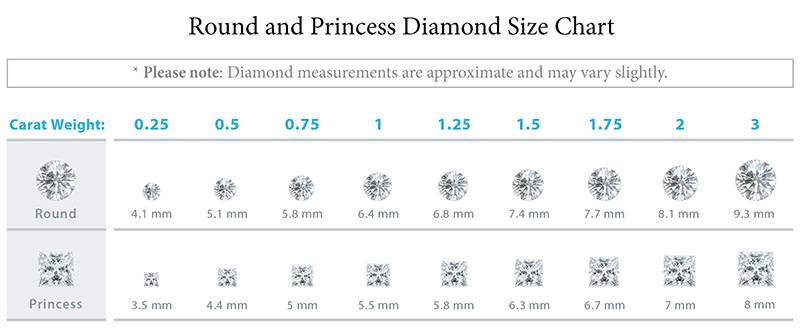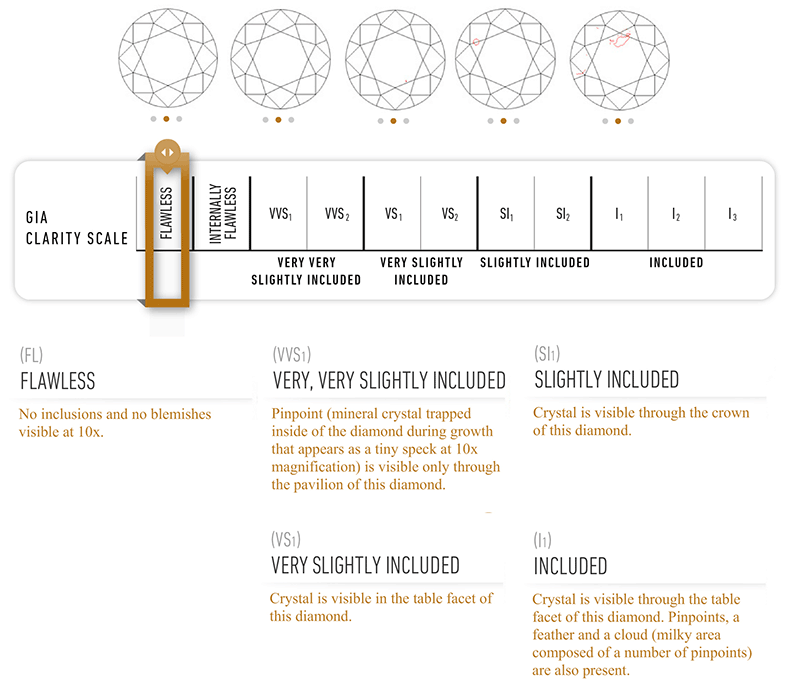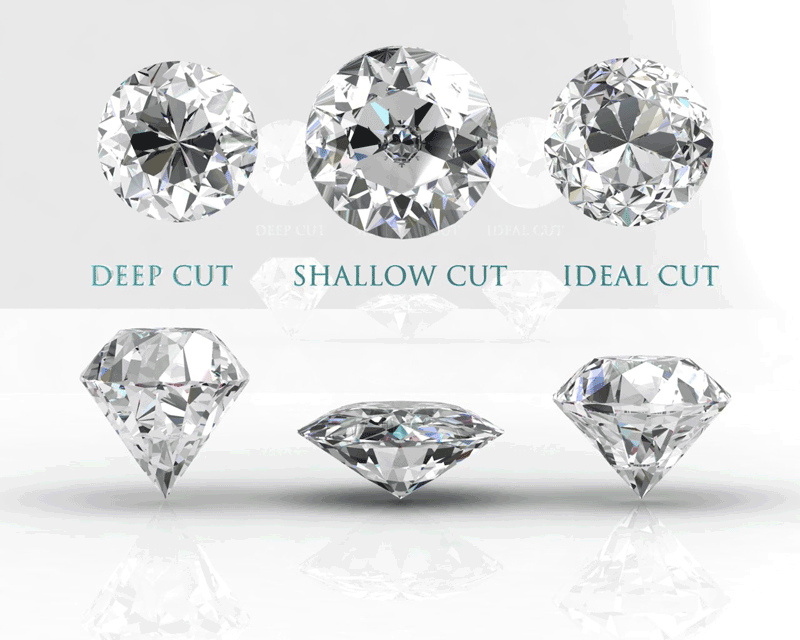The Four C�s
Cut
The cut is a measure of a diamond�s appearance and is arguably the most important of the Four Cs, as it has the largest impact on a diamond�s sparkle. Cut not only refers to the shape of a diamond but its proportions, symmetry and polish. The higher a diamond�s cut grade, the greater the stone�s brilliance. How a diamond is cut has a direct impact on these 3 main effects:
Brilliance:
The total light reflected from a diamond, sparkle
Fire:
The dispersion of light into the colours of the spectrum.
Scintillation:
The pattern of light and dark areas and the flashes of light when a diamond is moved.
The GIA uses the following scale to grade round brilliant diamonds:
Color
The color of a diamond measures the whiteness, essentially the lack of color, of a stone. The less color in a diamond, the higher its value. Diamonds are valued by how closely they approach colorlessness.
The GIA Color Scale measures from D (colorless, highest value and more rare) to Z (light yellow, grey or brown). Most diamonds used in jewellery and sold in jewellery stores are nearly colorless, as truly colorless diamonds are extremely rare. The size of the diamond will also have an impact on the perception of color, as it is more difficult to see the true color on a smaller stone.
The GIA�s color-grading scale for diamonds is the industry standard. Each letter grade has a clearly defined range of color appearance.
Carat
The carat weight of a diamond is the total weight, regardless of how it�s distributed. Carat is a measurement of weight, not size. One carat equals 200 milligrams, or 0.2 of a gram in weight. For diamonds under one carat, each carat is divided into 100 points; similar to pennies in a dollar.
2 diamonds of equal carat weight can have very different values when factoring in the components of the Four C�s.
Clarity
Diamonds are formed deep within the earth, under extreme heat and pressure and often contain unique imperfections, either internal (inclusions) or external (blemishes). Diamonds without inclusions or blemishes are rare, and most that contain them can only be viewed under magnification. These characteristics are unique to each stone and are a byproduct of its formation. They help gemologists separate natural diamonds from synthetics and simulants.
The clarity of a diamond refers to the extent that the inclusions and blemishes affect the appearance of a diamond. The GIA Clarity Scale includes eleven clarity grades ranging from Flawless to I3. Clarity is graded under 10x magnification.
Shapes
Choosing a diamond and gemstone shape is all about personal preference. With many shapes and cuts to pick from, there is one for every taste and style. A diamond�s shape refers to its physical form, and each diamond is very different with its own characteristics. The shape and cut will have an impact on the appearance of your diamond, giving each shape a unique fire and brilliance.
Round:
the round cut diamond is the most popular diamond shape, representing almost 75% of all diamonds sold and represents the highest advances in diamond cutting. The round diamond is generally superior to fancy shapes and the proper reflection of light maximizes potential brightness.
Oval:
the oval is a modified round cut with similar fire and brilliance. However, oval cuts have the added advantage of an elongated shape, which can create the illusion of a larger size.
Marquise:
the marquise cut gem is a football shaped, modified brilliant cut. Its unique shape creates the effect of a longer, more slender finger and hand.
Pear:
a pear cut is a teardrop shape, and its cut is a cross between a brilliant and a marquise. These should be symmetrical in width, and the point in line with the apex of the rounded end.
Emerald:
the emerald is traditionally rectangular with step cut faceting into the stone�s pavilion. Emerald cuts produce a hall-of mirror effect, with the interplay of light and dark planes. Inclusions and color are more apparent.
Princess:
a princess cut can be either square or rectangular, and show its color in the corners as well as the center, unlike most cuts which are only visible in the center of the stone. It is a very popular cut for engagement rings and is exceptionally brilliant.
Radiant:
A radiant cut features uniquely trimmed corners which combines the lines of an emerald cut with the brilliance of a round diamond. Radiant cuts have angled corners and can range from square or rectangular.
Cushion:
the cushion cut, also known as a pillow cut, has recently become popular due to their larger facets and round corners. This cut tends to have impeccable brilliance and clarity. These have qualities from both a princess and round cut stone. They can be square or rectangular.
Asscher:
an Asscher cut is often mistaken for an emerald cut because of its similar cut style, however an Asscher is square rather than rectangular. They have the same step faceting and unique glassy appearance, but tend to have more brilliance than an emerald cut.
.png)




.gif)




